The Indian Head penny is one of the most distinctive of American coins. And some examples can be worth a lot of money.
We’re going to take a closer look at the 1864 Indian Head penny value and its history. We’ll learn more about the different varieties. And we’ll discover what separates an everyday coin from something that’s rare and precious.
Ready? Let’s get started!
1864 Indian Head Penny Details
- Category: Indian Head pennies
- Mint: Philadelphia
- Mintage – Copper-Nickel: 13,740,000
- Mintage – Bronze: 39,233,714
- Obverse designer: James B. Longacre
- Reverse designer: James B. Longacre
- Edge: Plain
- Composition – Copper-Nickel: 88% copper, 12% nickel
- Composition – Bronze: 95% copper, 5% tin and zinc
- Diameter: 19.05 millimeters (0.75 inches)
- Weight – Copper-Nickel: 4.70 grams
- Weight – Bronze: 3.11 grams
1864 Indian Head Penny Value Chart |
||||
| Mint Mark, Composition and Color | XF45 | MS60 | MS65 | MS67 |
| 1864 (P) No Mint Mark Copper-Nickel Indian Head Penny Value | $135 | $250 | $1,400 | $26,500 |
| 1864 (P) No Mint Mark Bronze Indian Head Penny, Brown Value | $90 | $170 | $500 | $4,500 |
| 1864 (P) No Mint Mark Bronze Indian Head Penny, Red and Brown Value | n/a | n/a | $775 | $5,000+ |
| 1864 (P) No Mint Mark Bronze Indian Head Penny, Red Value | n/a | n/a | $1,250 | $23,000 |
| PR61 | PR63 | PR65 | PR67 | |
| 1864 (P) No Mint Mark Proof Copper-Nickel Indian Head Penny Value | $625 | $1,400 | $2,600
Cameo: $3,400 Deep Cameo: $9,000 |
$19,000
Cameo: $19,000 |
| 1864 (P) No Mint Mark Proof Bronze Indian Head Penny, Brown Value | $525 | $1,050 | $1,700 | $7,500 |
| 1864 (P) No Mint Mark Proof Bronze Indian Head Penny, Red and Brown Value | n/a | $1,500 | $2,600 | $14,000 |
| 1864 (P) No Mint Mark Proof Bronze Indian Head Penny, Red Value | n/a | n/a | $5,000 | n/a |
| 1864 (P) No Mint Mark Proof Bronze Indian Head Penny, Cameo Value | n/a | n/a | $16,000 | $37,500 |
| 1864 (P) No Mint Mark Proof Bronze Indian Head Penny, Deep Cameo Value | n/a | n/a | $21,000 | n/a |
1864 Indian Head Penny Values and Varieties Guides
1864 (P) No Mint Mark Copper-Nickel Indian Head Penny Value
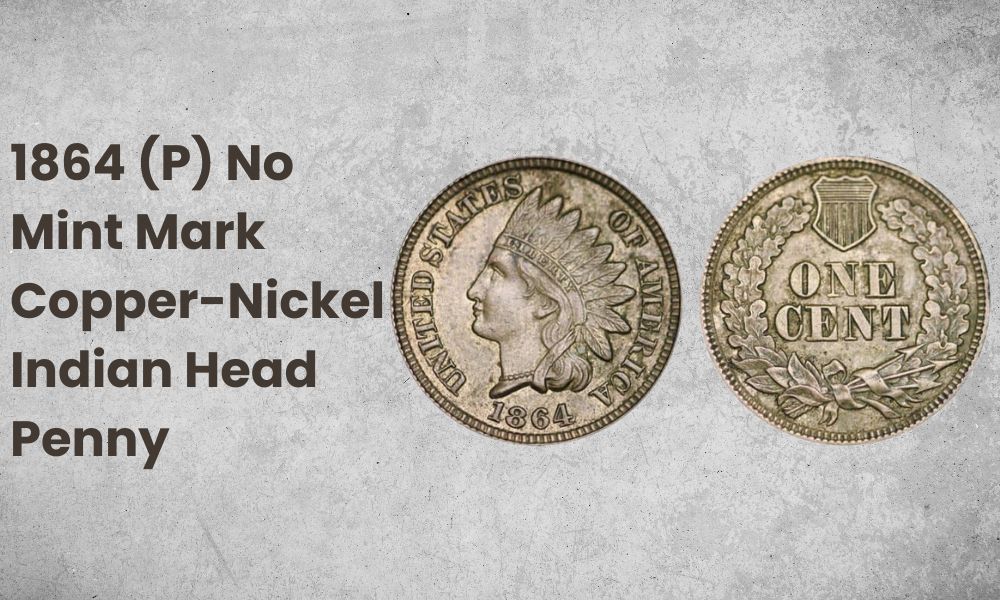
- Type: Indian Head Penny
- Edge: Plain
- Mint mark: None
- Place of minting: Philadelphia
- Year of minting: 1864
- Face value: $0.01 (one cent)
- $ price: $14 to $26,500
- Quantity produced: 13,740,000
- Designer: James B. Longacre
None of the Indian Head pennies minted in 1864 carry a mint mark. That’s because they were all struck in Philadelphia, the original Mint facility. They didn’t start place their first mint marks on coins until 1942.
1864 saw the Indian Head penny produced in two different metals. This is the copper-nickel version, sometimes referred to simply as “copper”. That’s despite it containing less copper than the bronze version – 88% compared to 95%.
It had the second lowest mintage of any copper-nickel cent between 1860 and 1864. Fewer than 14 million coins were struck. That compares to over 39 million made in bronze.
As a result, a copper-nickel Indian Head penny in any condition is a collectable coin. Values start at around $14 for examples in the poorest condition.
In uncirculated condition – known as “mint state” – values are much higher. Professional coin graders the PCGS value a coin graded MS60 at $250.
And gem quality coins are still rarer. The 1864 mintage is harder to find than copper-nickel cents from 1860 to 1863 at grades MS65 and above. A coin graded MS65 is today valued at $1,400, rising to $3,000 at MS66.
The finest known example is a single coin graded MS67. That’s valued by the PCGS at an impressive $26,500.
Look closely, too, for a tiny “L” on the ribbon behind Liberty’s neck. That stands for Longacre, the designer, and it was added to a small proportion of 1864 pennies. All other things being equal, a coin with the “L” can be worth up to four times as much as one without it.
1864 (P) No Mint Mark Bronze Indian Penny Value
- Type: Indian Head Penny
- Edge: Plain
- Mint mark: None
- Place of minting: Philadelphia
- Year of minting: 1864
- Face value: $0.01 (one cent)
- $ price: $10 to $35,000
- Quantity produced: 39,233,714
- Designer: James B. Longacre
The value of a bronze 1864 Indian Head penny can vary widely, depending on its condition and color.
A circulated coin in poor condition and in a brown color will be worth around $10. That increases to $55 for a brown coin graded “very fine” (VF25) and $90 for one graded “extremely fine” (XF45).
In mint state, brown coins range from $170 at MS60 to $500 at MS65. The finest example in this color is a single coin graded MS68. That was last sold at auction in 2019, when it realized a price of $5,760.
Red and brown coins are more desirable. Values start at around $20 for a coin graded “very good” (VG8). In mint state, that rises to $215 for a coin graded MS61 and $775 for a gem quality MS65 example.
The finest examples are five coins graded MS67. They come to the market only rarely, the most recent changing hands in 2018 for $1,328.
Prices have risen sharply since then, however. A red and brown penny graded MS66 sold for over $1,400 in November 2022. And the PCGS today attaches a value of $2,200 to coins graded MS66+.
But the most collectable color of all is red. Because copper changes color when it’s handled, red Indian Head pennies are almost by definition uncirculated. The PCGS values an MS62 red 1864 Indian Head penny at $275, increasing to $1,250 at MS65.
The finest known examples are two coins graded MS67+. They’re valued at $35,000 apiece.
1864 (P) No Mint Mark Copper-Nickel Proof Indian Head Penny Value
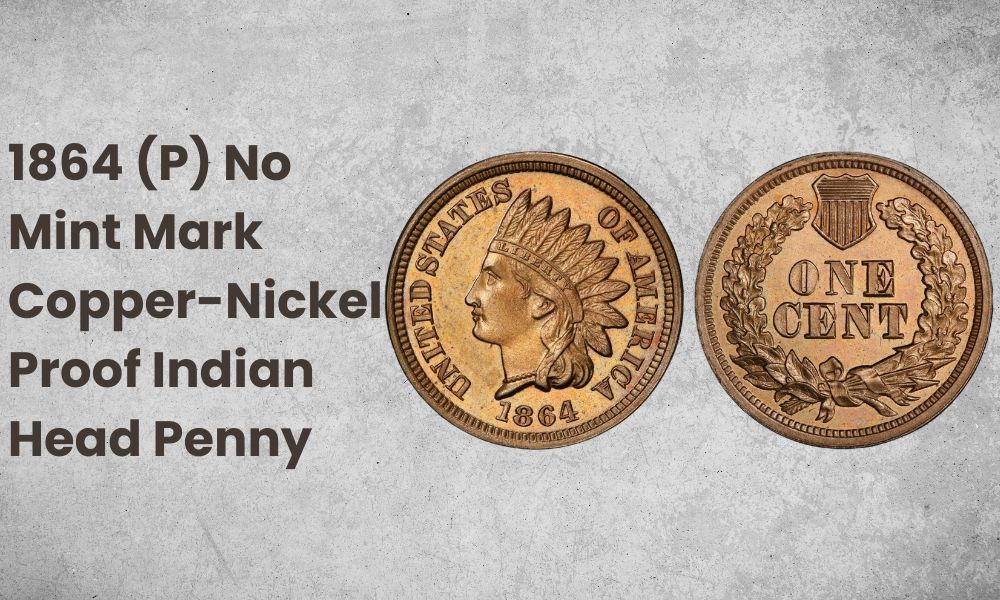
- Type: Indian Head Penny
- Edge: Plain
- Mint mark: None
- Place of minting: Philadelphia
- Year of minting: 1864
- Face value: $0.01 (one cent)
- $ price: $3,000 to $12,500
- Quantity produced: 370
- Designer: James B. Longacre
Proof coins are those produced to particularly high standards. They use specially crafted dies and are struck on highly polished planchets.
These days, large numbers of proofs are struck for collectors. But back in 1864, coin collecting was still a very niche occupation. And only 370 proof Indian Head pennies were struck on copper-nickel planchets.
That makes any of these coins desirable to collectors. Values begin at about $3,000 for a proof graded PR63. The finest known examples are four coins graded PR66, each worth about $12,500.
1864 (P) No Mint Mark Bronze Proof Indian Head Penny Value
- Type: Indian Head Penny
- Edge: Plain
- Mint mark: None
- Place of minting: Philadelphia
- Year of minting: 1864
- Face value: $0.01 (one cent)
- $ price: $425 to $37,500
- Quantity produced: 150
- Designer: James B. Longacre
Even fewer 1864 proof Indian Head pennies were struck in bronze than in copper-nickel. Just 150 of them were made, meaning they’re both rare and valuable.
If you want to add one to your collection, you’ll be looking at spending at least $435. That should be enough to buy a brown proof graded PR60. If you want a red and brown proof, the minimum spend is $1,500 (PR63), and for a red proof it’s $2,150 (PR64).
Amongst the population there are also coins designated “cameo” or “deep cameo”. These have an attractive contrast between frosted designs and glossy fields. In order for a coin to be designated a deep cameo, the contrast must be particularly marked.
An 1864 Indian Head proof penny designated a cameo is valued at $5,000 at PR64. The finest known example is a single coin graded PR67 and valued at $37,500.
Deep cameos are only known at grades PR64, PR65 and PR66. The PCGS values a PR65 example at $21,000. Only one deep cameo has been graded PR66. It came up for sale five times between 2002 and 2013, with the peak price of $18,400 achieved in 2002.
Also Read: Top 15 Most Valuable Indian Head Penny Worth Money
1864 Indian Head Penny History
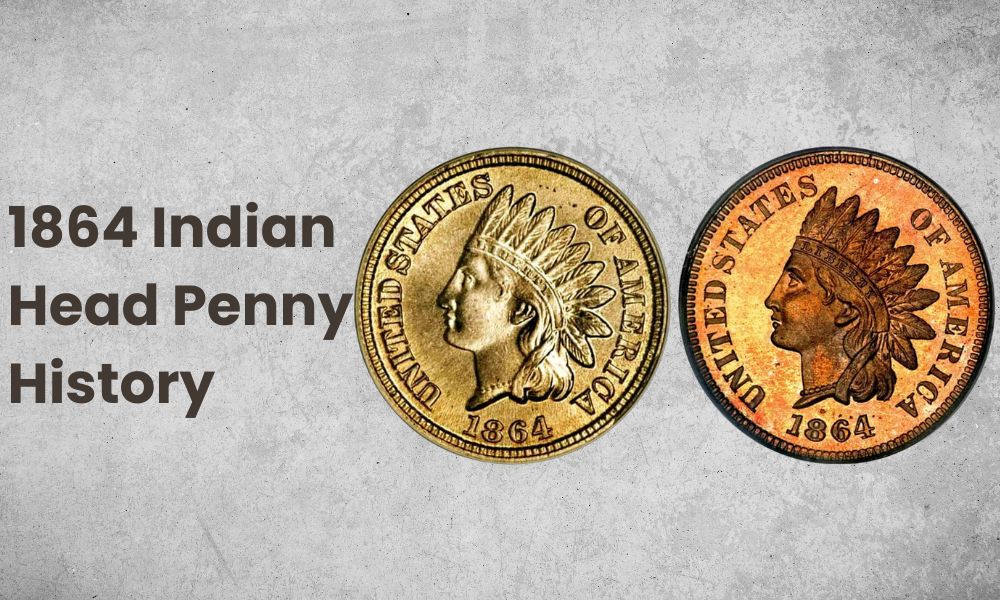
The Indian Head penny is so called because of the image on the obverse. That shows Lady Liberty wearing the feathered headdress of a Native American warrior.
The design caused a stir, even at the time. Placing such a headdress on a female, and a white female at that, was controversial. Even the Mint Director, James Snowden, called it an “absurd incongruity”. Nevertheless, the Indian Head penny is one of the most beloved of all American coins.
The design was the work of James Barton Longacre, the Mint’s Chief Engraver. The first coins were struck for circulation in 1859. They were made to the same recipe as the Flying Eagle pennies which had preceded them – 88% copper and 12% nickel.
But in 1864, that composition changed. While some pennies continued to be made from copper-nickel that year, others were struck on planchets made from 95% copper. (The remaining 5% was a mixture of tin and zinc.)
The new recipe reduced the weight of the coin from 4.7 to 3.1 grams. Thereafter, all Indian Head pennies were made in bronze.
Until 1907, all pennies were struck at the mint facility in Philadelphia. From 1908 that changed, and the coins were struck at San Francisco too.
The series continued until 1909 when a new design was initiated to mark the centenary of Lincoln’s birth. The Lincoln penny, as that became known, is still in production today.
Also Read: Top 20 Most Valuable Old Pennies Worth Money (Penny Collection)
1864 Indian Head Penny Grading
Grading your Indian Head penny starts with knowing whether it’s made of copper-nickel or bronze. To be sure, weigh your coin. If it’s 4.7 grams, it’s copper-nickel. If it’s 3.1 grams, it’s bronze.
For bronze coins, the color will affect value. Is your coin red across at least 95% of its surface area? If so, it’s red. If it’s brown across at least 95% of the surface, it’s brown. And if it’s somewhere in between, it’s red and brown.
Then inspect the surface for signs of wear and tear. A flawless coin without any wear, scratches or hairlines is graded 70. A coin where you can only just make out the date, type and mint mark is graded 1.
1864 Indian Head Penny Errors
1864 Copper-Nickel Indian Head Penny, Polished Die
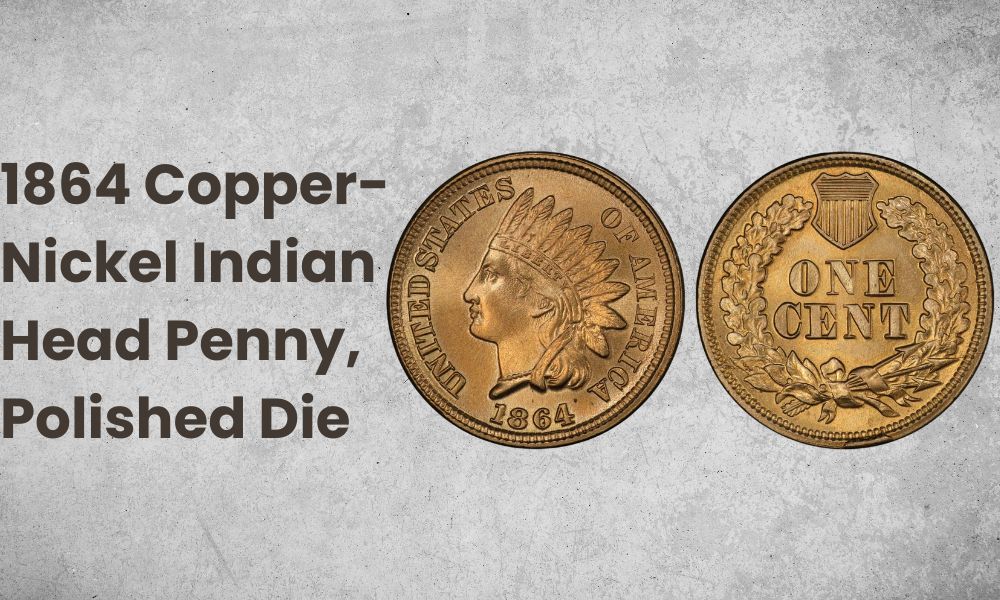
A small number of the Indian Head pennies made from copper nickel show marks where the die was polished. These appear as strong vertical lines over Liberty’s ear. You may see this error identified in coin catalogs with the code FS-401 S-5.
Even poorer quality coins with this error are valuable. A coin graded 4 is valued at $100 by the PCGS. That increases to $3,600 for the finest known examples, graded MS66.
1864 Bronze Penny, Lathe Lines
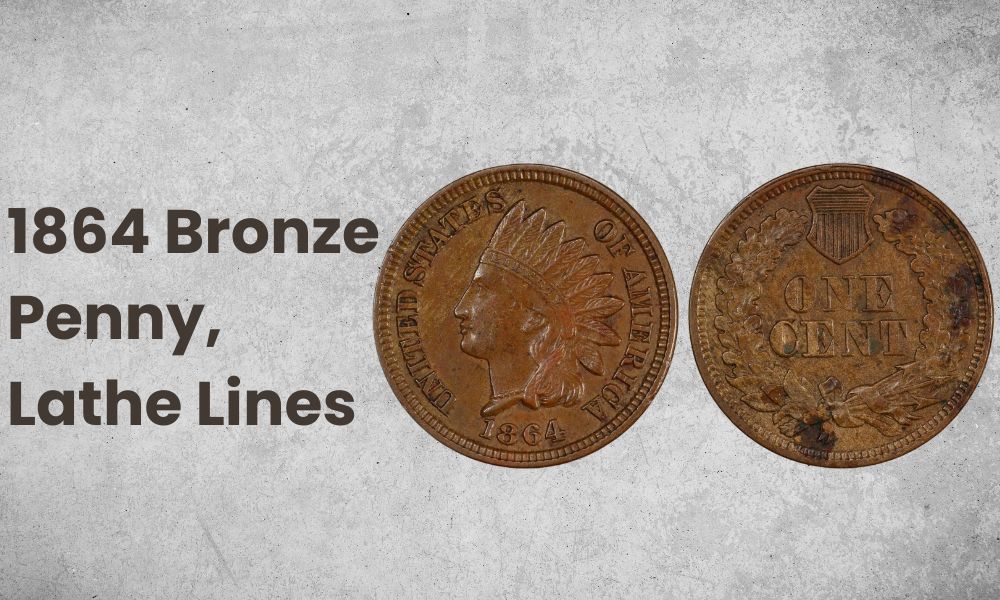
Some bronze pennies also show signs of the manufacturing process. A few coins show lathe lines – lines made by the lathe on the die used to strike the coins. These produce faint, concentric circles over Liberty’s face.
This error is coded FS-1401 S-11. A brown coin with this error, graded MS65, sold at auction in 2022 for just under $400.
1864 Copper-Nickel Penny, Re-Punched Date
Some of the 1864 copper-nickel pennies had the date punched on them a second time. You’ll need a coin microscope or loupe to spot this.
Look carefully at the digits, and you may see the ghost of the first date next to or below them. It’s usually most obvious on the “6” and the “4”.
A coin with this error, certified genuine by the PCGS, came up for auction on eBay in 2018. It was ungraded because of environmental damage. It did, though, include the desirable “L” on the ribbon of Liberty’s headdress. It sold for $58.
This YouTube video from Couch Collectables provides more information on the errors amongst 1864 Indian Head pennies.
FAQs
Is an 1864 Indian Head penny copper or bronze?
It could be either. Both proofs and business strike Indian Head pennies were made in copper-nickel and in bronze that year.
Weighing your coin is the easiest way to check what type you have. Copper-nickel Indian Head pennies weigh 4.7 grams, bronze ones only 3.1 grams.
What Indian Head pennies are worth a lot of money?
All Indian Head pennies are collectable, but the better their condition, the more valuable they’ll be.
The auction record for an Indian Head penny was set in March 2021. The coin in question was dated 1897 and was a deep cameo graded PR67+. It sold for $108,000.
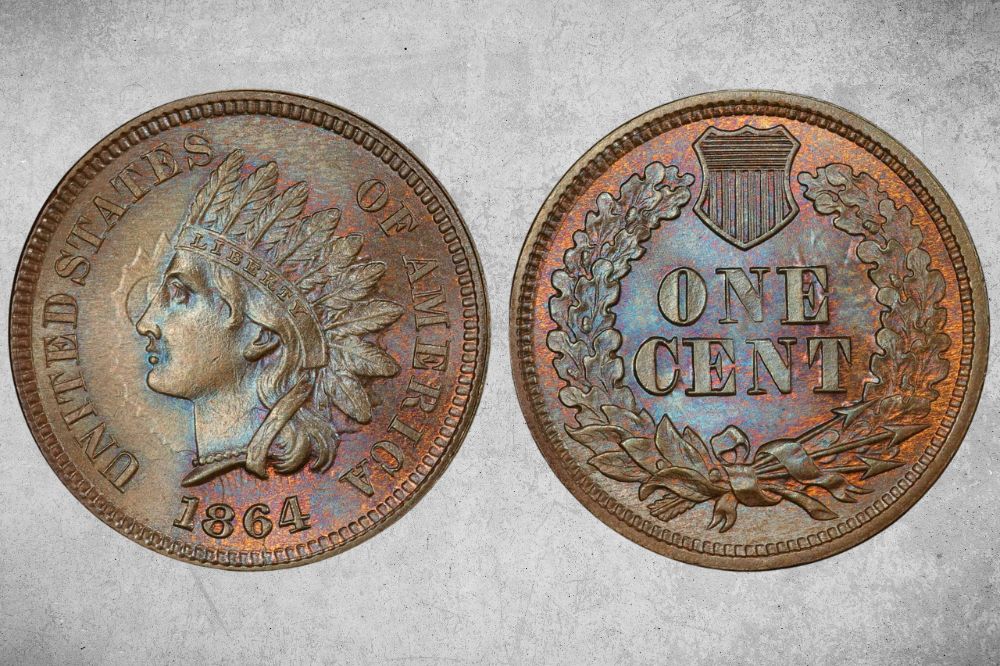
I actually have a 1980 5 cent coin that looks like it’s made from copper or possibly bronze. It’s the same size as a regular nickel but it doesn’t stick to a magnet. I can’t seem to find anything about a coin like this other than ones that have been stuck on a penny which doesn’t seem to be the case here. Anything you might be able to tell me would be great. Thanks